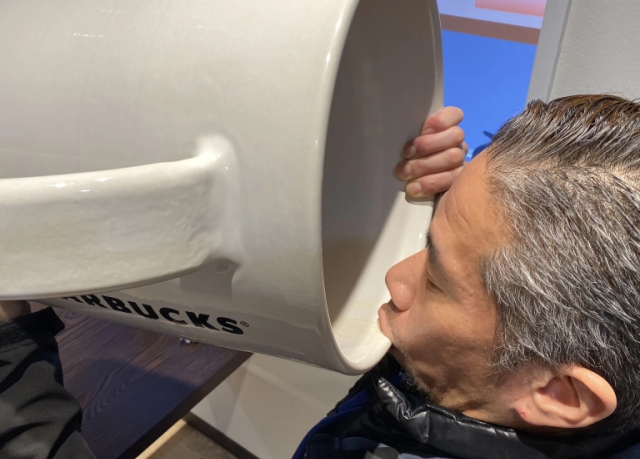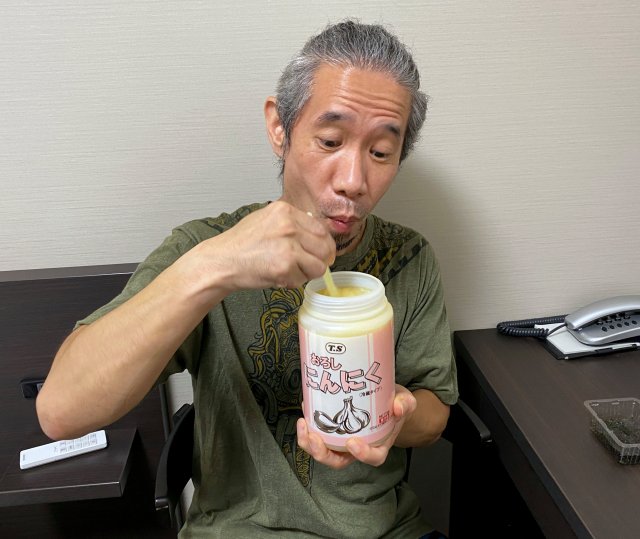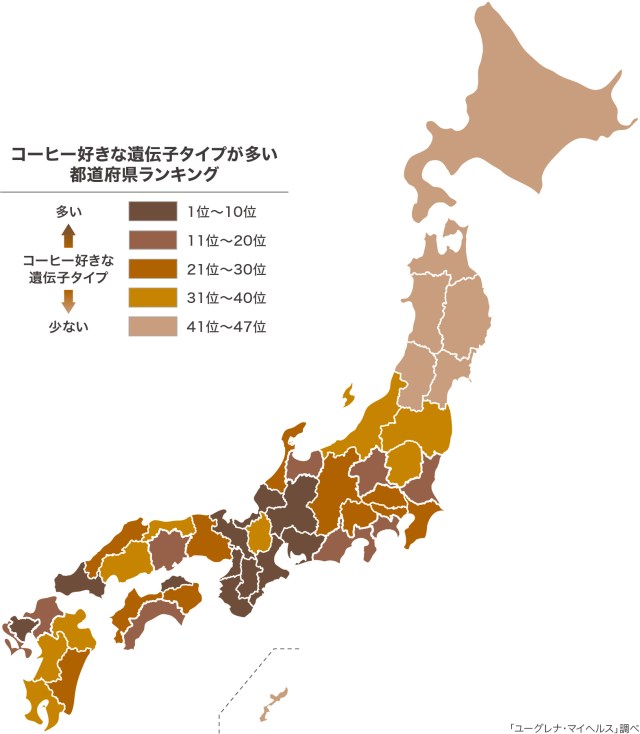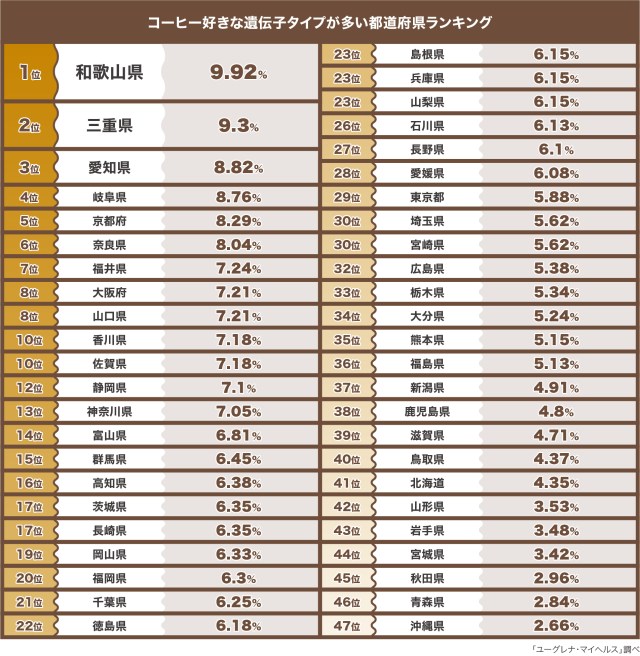
Wake up and smell the genomes.
As the old saying goes, “you are what you eat,” but recent research is showing that “we eat what we are” might be more accurate. In other words, our tastes and dietary habits might have more to do with what’s embedded in our DNA than we had previously thought.
One gene that has been of particular interest is ALDH2, which controls the enzymes used in alcohol metabolism. This is the same gene that results in redness that appears on the faces of many East Asians who partake of alcohol, but now is believed to be related to a number of other traits from alcohol dependence to quality of sleep, as well as other dietary preferences.
▼ Mr. Sato appears to have the ALDH2 genotype that processes alcohol fully, as his face remains fair after drinking. They only way you could tell he was wasted was the way he eats grated garlic from a jar.

For example, according to Tokyo-based genome data analysis firm Euglena, the rs671 genotypes of ALDH2 have a relation to the amount of coffee someone likes to consume on a daily basis. Euglena then used the data of 20,000 people from all over Japan and found which prefectures have the most and least number of genetically predisposed coffee lovers.
They also illustrated the results in this playfully coffee-colored heat map, in which darker areas represent the highest population of coffee-craving genotypes and vice versa.
As we can see, there is a considerably stronger concentration of these people in the western part of Japan, particularly the Kansai region, composed of prefectures such as Osaka and Kyoto. As the detailed data reveals, four of the six main Kansai prefectures appear in the top ten genetically coffee-loving prefectures:
Prefectures with most people whose genes suggest they like coffee
1. Wakayama
2. Mie
3. Aichi
4. Gifu
5. Kyoto
6. Nara
7. Fukui
8 (tie). Osaka, Yamaguchi
10 (tie). Kagawa, Saga
Other prefectures like Mie and Fukui are sometimes grouped in with the Kansai area as well bringing the total up to six.
Conversely, the geographic extremities of Japan also seem to be the less susceptible to the aroma of freshly brewed coffee. The southern islands of Okinawa came in dead last among prefectures and northernmost Hokkaido ranked 41st out of 47.
▼ Full ranking in English listed at the end of this article
Interestingly, according to economic census data from the Ministry of Internal Affairs and Communication many of the same prefectures that tested highly for genetic predilection for coffee also have the most coffee shops per capita.
Prefectures with most coffee shops per capita (shops/1,000 people)
1. Kochi (1.56)
2. Gifu (1.43)
3 (tie). Aichi, Wakayama (1.13)
5. Osaka (1.06)
6. Hyogo (0.97)
7. Kagawa (0.93)
8. Kyoto (0.92)
9. Mie (0.86)
10. Fukui (0.83)
Although not in the top ten, Kochi was still a respectable 16th in terms of coffee-drinking genes. Its first-place performance here might also have been swayed by it having the third-lowest population in the country. Hyogo, on the other hand, is pretty far down the list at 23rd place but percentage-wise isn’t too far away from Kochi in terms of people with the genotypes in question.
In the end, this data does little more than provide some fun and perhaps highlight some prime opportunities to open coffee shops in Wakayama and Mie. But more importantly, the science behind it is bringing us closer to identifying potential lifestyle illnesses we might be at risk of falling victim to one on a genetic level without ever realizing it.
Full list of Japanese prefectures ranked by population of people genetically predisposed to drink coffee (percentage of population)
1.Wakayama (9.92)
2. Mie (9.3)
3. Aichi (8.82)
4. Gifu (8.76)
5. Kyoto (8.29)
6. Nara (8.04)
7. Fukui (7.24)
8 (tie). Osaka, Yamaguchi (7.21)
10 (tie). Kagawa, Saga (7.18)
12. Shizuoka (7.1)
13. Kanagawa (7.05)
14. Toyama (6.81)
15. Gunma (6.45)
16. Kochi (6.38)
17 (tie). Ibaraki, Nagasaki (6.35)
19. Okayama (6.33)
20. Fukuoka (6.3)
21. Chiba (6.25)
22. Tokushima (6.18)
23 (tie). Shimane, Hyogo, Yamanashi (6.15)
26. Ishikawa (6.13)
27. Nagano (6.1)
28. Ehime (6.08)
29. Tokyo (5.88)
30 (tie). Saitama, Miyazaki (5.62)
32. Hiroshima (5.38)
33. Tochigi (5.34)
34. Oita (5.24)
35. Kumamoto (5.15)
36. Fukushima (5.13)
37. Niigata (4.91)
38. Kagoshima (4.8)
39. Shiga (4.71)
40. Tottori (4.37)
41. Hokkaido (4.35)
42. Yamagata (3.53)
43. Iwate (3.42)
44. Miyagi (3.42)
45. Akita (2.96)
46. Aomori (2.84)
47. Okinawa (2.66)
Source: PR Times
Top image: ©SoraNews24
Insert images: PR Times (unless otherwise noted)
● Want to hear about SoraNews24’s latest articles as soon as they’re published? Follow us on Facebook and Twitter!



 When do Japanese women have their first kiss? Survey finds gap between different parts of Japan
When do Japanese women have their first kiss? Survey finds gap between different parts of Japan Online survey sheds light on prefectural personality rankings of Japanese people
Online survey sheds light on prefectural personality rankings of Japanese people Japan’s top 10 cat names for 2017
Japan’s top 10 cat names for 2017 Japan’s top 10 dog names for 2017
Japan’s top 10 dog names for 2017 The top 10 universities in Japan determined by 2021 World University Rankings
The top 10 universities in Japan determined by 2021 World University Rankings How to order snacks on a Shinkansen bullet train in Japan
How to order snacks on a Shinkansen bullet train in Japan Demon Slayer: Kimetsu no Yaiba gets new roller coaster attractions and food at Universal Studios Japan
Demon Slayer: Kimetsu no Yaiba gets new roller coaster attractions and food at Universal Studios Japan New samurai glasses are Japan’s latest weird must-have souvenir
New samurai glasses are Japan’s latest weird must-have souvenir Burger King Japan suddenly adds Dr. Pepper and Dr. Pepper floats to its menu nationwide
Burger King Japan suddenly adds Dr. Pepper and Dr. Pepper floats to its menu nationwide Nintendo history you can feel – Super NES, N64, and GameCube controllers become capsule toys
Nintendo history you can feel – Super NES, N64, and GameCube controllers become capsule toys High-fashion Totoro cuddle purse is like an elegant stroll in the forest【Photos】
High-fashion Totoro cuddle purse is like an elegant stroll in the forest【Photos】 Japan’s new difficult-to-drink-from beer glass protects your liver, but it’s a brutal experience
Japan’s new difficult-to-drink-from beer glass protects your liver, but it’s a brutal experience Kyoto Tower mascot termination reveals dark side behind cute Japanese characters
Kyoto Tower mascot termination reveals dark side behind cute Japanese characters New Pokémon ice cream, dessert drinks, and cool merch coming to Baskin-Robbins Japan【Pics】
New Pokémon ice cream, dessert drinks, and cool merch coming to Baskin-Robbins Japan【Pics】 To combat declining birth rate, Japan to begin offering “Breeding Visas” to foreigners
To combat declining birth rate, Japan to begin offering “Breeding Visas” to foreigners Hello, cosmetics! Clinique teams up with Hello Kitty this summer for first-time collaboration
Hello, cosmetics! Clinique teams up with Hello Kitty this summer for first-time collaboration “The most Delicious Cup Noodle in history” – Japan’s French Cup Noodle wins our heart【Taste test】
“The most Delicious Cup Noodle in history” – Japan’s French Cup Noodle wins our heart【Taste test】 Starbucks releases a cute Frappuccino and Unicorn Cake…but not in Japan
Starbucks releases a cute Frappuccino and Unicorn Cake…but not in Japan McDonald’s Japan’s Soft Twist Tower: A phantom ice cream only sold at select branches
McDonald’s Japan’s Soft Twist Tower: A phantom ice cream only sold at select branches Yabai Ramen: What makes this Japanese ramen so dangerous?
Yabai Ramen: What makes this Japanese ramen so dangerous? Finally! Nintendo Japan expands Switch 8-bit controller sales to everybody, Online member or not
Finally! Nintendo Japan expands Switch 8-bit controller sales to everybody, Online member or not Japanese government wants to build luxury resorts in all national parks for foreign tourists
Japanese government wants to build luxury resorts in all national parks for foreign tourists 10 things you should buy at 7-Eleven in Japan
10 things you should buy at 7-Eleven in Japan Studio Ghibli releases anime heroine cosplay dresses that are super comfy to wear
Studio Ghibli releases anime heroine cosplay dresses that are super comfy to wear Woman charged for driving suitcase without a license in Osaka
Woman charged for driving suitcase without a license in Osaka Studio Ghibli unveils My Neighbour Totoro miniature house model
Studio Ghibli unveils My Neighbour Totoro miniature house model Kyoto experiencing problems with foreign tourists not paying for bus fares, but not on purpose
Kyoto experiencing problems with foreign tourists not paying for bus fares, but not on purpose Fighting mild hunger with a Japanese soda that turns into jelly in the stomach【Taste test】
Fighting mild hunger with a Japanese soda that turns into jelly in the stomach【Taste test】 Studio Ghibli’s Howl’s Moving Castle tapestry unveiled in Japan for first time
Studio Ghibli’s Howl’s Moving Castle tapestry unveiled in Japan for first time McDonald’s new Happy Meals offer up cute and practical Sanrio lifestyle goods
McDonald’s new Happy Meals offer up cute and practical Sanrio lifestyle goods Sales of Japan’s most convenient train ticket/shopping payment cards suspended indefinitely
Sales of Japan’s most convenient train ticket/shopping payment cards suspended indefinitely Sold-out Studio Ghibli desktop humidifiers are back so Totoro can help you through the dry season
Sold-out Studio Ghibli desktop humidifiers are back so Totoro can help you through the dry season Japanese government to make first change to romanization spelling rules since the 1950s
Japanese government to make first change to romanization spelling rules since the 1950s Foreigner’s request for help in Tokyo makes us sad for the state of society
Foreigner’s request for help in Tokyo makes us sad for the state of society Ghibli founders Toshio Suzuki and Hayao Miyazaki contribute to Japanese whisky Totoro label design
Ghibli founders Toshio Suzuki and Hayao Miyazaki contribute to Japanese whisky Totoro label design Doraemon found buried at sea as scene from 1993 anime becomes real life【Photos】
Doraemon found buried at sea as scene from 1993 anime becomes real life【Photos】 Tokyo’s most famous Starbucks is closed
Tokyo’s most famous Starbucks is closed Princesses, fruits, and blacksmiths: Study reveals the 30 most unusual family names in Japan
Princesses, fruits, and blacksmiths: Study reveals the 30 most unusual family names in Japan The 10 best places for young, single people to live in and around Tokyo【Survey】
The 10 best places for young, single people to live in and around Tokyo【Survey】 What do Japanese kids want to be when they grow up? Businesspeople
What do Japanese kids want to be when they grow up? Businesspeople “YouTuber” slides way down list of top professions Japanese kids aspire to
“YouTuber” slides way down list of top professions Japanese kids aspire to What should Tokyo’s newest rail station be called? Poll asks high school girls for their opinion
What should Tokyo’s newest rail station be called? Poll asks high school girls for their opinion “Scholar” tops list of what Japanese boys want to be when they grow up, “restauranteur” for girls
“Scholar” tops list of what Japanese boys want to be when they grow up, “restauranteur” for girls How often do Japanese high school kids watch anime, and do boys and girls watch the same series?
How often do Japanese high school kids watch anime, and do boys and girls watch the same series? Japanese travel agency reveals summer 2022’s most popular destinations domestically and abroad
Japanese travel agency reveals summer 2022’s most popular destinations domestically and abroad The most popular places in Japan for viewing sakura in 2024, according to local travel agency
The most popular places in Japan for viewing sakura in 2024, according to local travel agency Japan’s favorite Pokémon types by prefecture–which types are the most popular?
Japan’s favorite Pokémon types by prefecture–which types are the most popular? What do Japanese kids want to be when they grow up? For 30 percent of boys, YouTubers, survey says
What do Japanese kids want to be when they grow up? For 30 percent of boys, YouTubers, survey says Is roughly half of Japan preconditioned to hate mint chocolate sweets?
Is roughly half of Japan preconditioned to hate mint chocolate sweets? Emperors, anime icons, and porn stars show up in six-nation survey of most famous Japanese people
Emperors, anime icons, and porn stars show up in six-nation survey of most famous Japanese people Japanese breast size study shows rapid growth in previously smallest-busted region of county
Japanese breast size study shows rapid growth in previously smallest-busted region of county Japanese city makes list of world’s top 10 most livable cities, but not one most people expected
Japanese city makes list of world’s top 10 most livable cities, but not one most people expected Foreign travelers now spend more money in Japan than ever before, surprise country at top of list
Foreign travelers now spend more money in Japan than ever before, surprise country at top of list
Leave a Reply